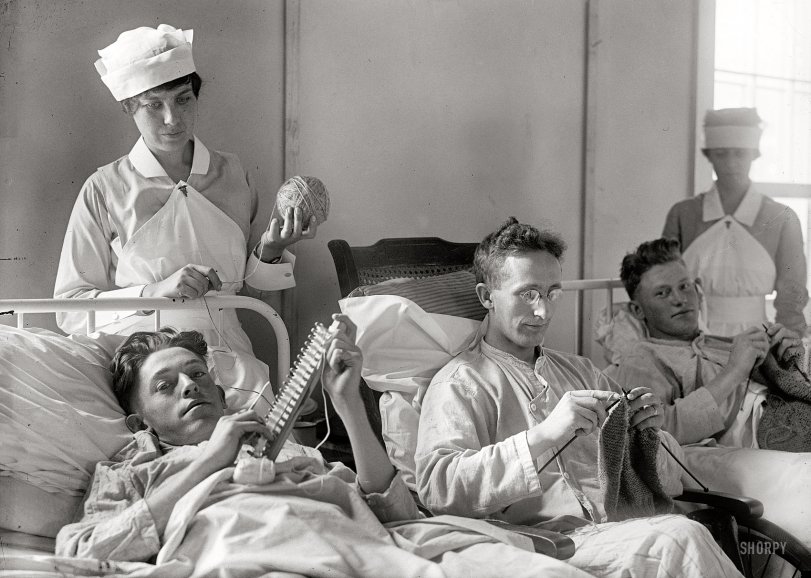


Framed or unframed, desk size to sofa size, printed by us in Arizona and Alabama since 2007. Explore now.
Shorpy is funded by you. Patreon contributors get an ad-free experience.
Learn more.

- Texas Flyer wanted
- Just a Year Too Soon
- WWII -- Replacing men with women at the railroad crossing.
- Yes, Icing
- You kids drive me nuts!
- NOT An Easy Job
- I wonder
- Just add window boxes
- Icing Platform?
- Indiana Harbor Belt abides
- Freezing haze
- Corrections (for those who care)
- C&NW at Nelson
- Fallen Flags
- A dangerous job made worse
- Water Stop
- Passenger trains have right of way over freights?
- Coal
- Never ceases to amaze me.
- Still chuggin' (in model form)
- Great shot
- Westerly Breeze
- For the men, a trapeze
- Tickled
- Sense of loneliness ...
- 2 cents
- Charm City
- What an Outrage
- Brighton Park
- Catenary Supports
Print Emporium
A Ball of Yarn: 1918

Washington, D.C., circa 1918. "Soldiers at Walter Reed." Harris & Ewing Collection dry-plate glass negative. View full size.
Glad to be part of the tradition!
I was an Army Occupational Therapist at WRAMC in 1985 and I learned how to knit from my patients on the psychiatric unit. Since then the artist in me has learned to spin wool, and create my own patterns as well. Knitting is an extremely healing art form, requiring concentration, attention to detail, problem solving, and abstract thinking skills just to name a few benefits. I'm male by the way, glad to be in the company of Russell Crowe.
Real Men Knit...
Knitting, until the invention of the knitting machine, was a man's occupation. Sailors knitted (as an off-shoot of making nets). When the knitting machine was invented, they could pay women low wages as "unskilled labourers" and knitting became "women's work".
Russell Crowe is a knitter, so is Laurence Fishburne, Montreal Canadien Hoceky player Jacques Plante was, Antonio Banderas learned to knit from Catherine Zeta-Jones while recovering from an injury (he taught Melanie Griffith), Rosie Greer and Randy Grossman do (Rosie does needlepoint and crocheting)....
Connection
The third soldier's smile made me smile back at him across all the years. I pray he healed mentally and physically, that they all did.
My boyfriend knows how to knit. He's Scottish. He's also a 2nd level blackbelt, so I wouldn't mock.
Beatific
It's nice to see no dopey comments about these guys for once. Who knows what these men went through? God bless them all, both then and now.
I love the beatific expressions in the nurses' faces. The picture just projects such a kind and gentle feeling.
Tough guys knitting
In his youth, my uncle had surgery on his ankle. To occupy his mind and fingers, the nurses taught him how to knit, crochet and tat. As he grew to an adult, he kept on knitting, crocheting and a bit of tatting. Today he is in his late 70s and still knits and crochets.
Homogeneity?
I'm confused. Ok, five figures, two women, three men, all look human, no chimps, gorillas or bonobos. Because they are all white? Or because the men are holding incomplete knitted objects? Or the woman look attentive and focused? Or the image looks staged?
One has a knitting rake, used to make socks by unskilled knitters. The other two are at least holding the needles like they know how to knit. The second man is wearing pince-nez, the others, sans glasses. During the war, knitting was something asked of all people, to free production of fabrics for war materials.
Everyone in America would know, at the time, what was being made and why.
Sweater
The soldier in the middle appears to be working on a sweater sleeve. You can see the ribbing on the bottom edge. From the size, the soldier on the right is working on the same thing.
A common thread
There's definitely some homogeneity in this shot. I'd like to see the finished product of their knitting.
An old yarn
Soldier on the left is holding knitting frame.
























On Shorpy:
Today’s Top 5